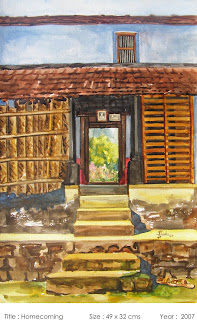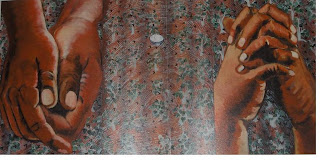Both the exhibitions are inspired by nature but they differ greatly in the treatment and the result is for all to see.
Paika Alaka Rau presents her recent watercolors titled ‘Homecoming’. Her paintings are fairly conventional, brightly colorful and celebrate the traditional realism in landscapes. She says, “Although urbanization has brought in notable changes in the village scenario, I have tried to avoid them in my paintings and endeavored to capture the old ambience. A parallel may be observed in the style I follow. The world may have forayed into various levels of abstraction, aided by technological advancements. But personally, I enjoy capturing nature’s magnificence in her purest and untouched form.”

The exhibition is on till February 27, between 10:00 am - 7:00 pm daily at Bharatiya Vidya Bhavan, E Hanumantha Rao Art Gallery, Race Course Road, Bangalore –1
‘Linear Rhythm’ is an exhibition of recent works in different mediums by artist Ilaa Pal. The series is inspired by nature, and is mostly black and white. The works appear like fleeting glimpses of nature captured from a distance – subtle lines and patches of pigment delineate the canvas, and suggestive of a landscape. With minimal brush strokes, the landscapes hint at the topographical patterns, since the effect is of mist and haziness. There are a few paintings on silk as well, that are also inspired by nature. Pal is a self-taught painter, and has worked with MF Husain for two years. She lives in Mumbai.

The exhibition is on till February 28 between 11:00 am - 7:00 pm Monday to Saturday, at Time and Space Gallery, 55, Lavelle Road, Bangalore -1.
(Published in Financial Times, Bangalore)



 Anil Kumar offers unusual imagery in his ‘Magical hat of colonial king’ and ‘Public call’. All his works have been done with pastels on paper. Reji Arackal has a humorous take on ‘operations’ – with wrestler like figures slicing at different fruit. An acrylic painting of an exaggerated figure of a woman holding an ice cream stick looks ferocious, and at the same time has a child like glee on her face. The artist likes to combine local motifs and objects in his paintings. Pierced eyebrows and earrings are meant to be pure decorations, probably to emphasize the feminine side to a wrestler like woman. Another still life with a huge jackfruit – bright green and exquisitely detailed is placed next to a couple of apples has an unusual effect. KS Sujith paints a surreal picture where animals and humans cohabit in a bright, vividly colorful and painstakingly detailed world full of foliage. Gigantic reptilian figures overlook the tiny monkey like human figures.
Anil Kumar offers unusual imagery in his ‘Magical hat of colonial king’ and ‘Public call’. All his works have been done with pastels on paper. Reji Arackal has a humorous take on ‘operations’ – with wrestler like figures slicing at different fruit. An acrylic painting of an exaggerated figure of a woman holding an ice cream stick looks ferocious, and at the same time has a child like glee on her face. The artist likes to combine local motifs and objects in his paintings. Pierced eyebrows and earrings are meant to be pure decorations, probably to emphasize the feminine side to a wrestler like woman. Another still life with a huge jackfruit – bright green and exquisitely detailed is placed next to a couple of apples has an unusual effect. KS Sujith paints a surreal picture where animals and humans cohabit in a bright, vividly colorful and painstakingly detailed world full of foliage. Gigantic reptilian figures overlook the tiny monkey like human figures.